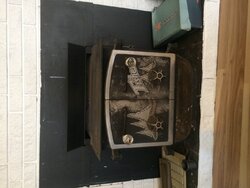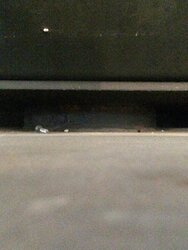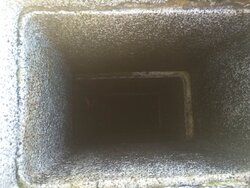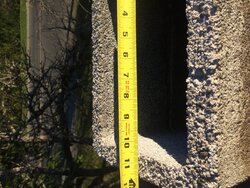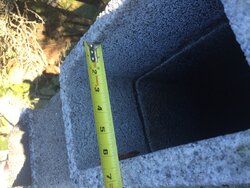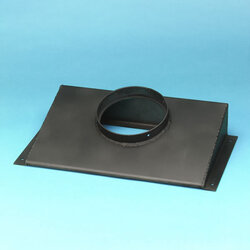Bought a house recently and had the plan of getting the woodstove going in the basement, and now am getting information about being able to do that and not sure about the possibility. Its an old fisher woodstove (looks like this one https://www.hearth.com/images/uploads/fischermanual.pdf). I was told I would need to get a chimney liner when we did the house inspection, which seemed fine. Had the guy come today to look and do an estimate, he said that the largest chimney liner they could do would be 5 1/2 inches. As far as I can tell the collar on the stove is 8 inches. In my reading it seems you don't want to downsize in the chimney liner - so what sort of problems would this cause? The guy from the chimney company said it would give me problems and figured I would always get smoke into the house when I opened the door due to problems with the draft. If I replaced the stove and found one with a 5 1/2 inch collar would this make a difference? Really don't know much about chimneys but would like to have the woodstove working.
Old fisher woodstove and a new chimney liner
- Thread starter kelly.alan
- Start date
-
Active since 1995, Hearth.com is THE place on the internet for free information and advice about wood stoves, pellet stoves and other energy saving equipment.
We strive to provide opinions, articles, discussions and history related to Hearth Products and in a more general sense, energy issues.
We promote the EFFICIENT, RESPONSIBLE, CLEAN and SAFE use of all fuels, whether renewable or fossil.
You are using an out of date browser. It may not display this or other websites correctly.
You should upgrade or use an alternative browser.
You should upgrade or use an alternative browser.
- Status
- Not open for further replies.
Whats the diameter of your chimney and flu now? I would get a second estimate...I just went through it and found that most are lazy and want to leave the existing clay liner installed, and use no insulated wrap or downsized pipe. Both are the wrong way to go. Knowing what you have now for a chimney....inside diameter and if it's brick or clay lined would help.
Planning on getting a second estimate for sure. Although the company that came seems to be one that is highly recommended. I was just up on the roof and took a few pictures of the chimney and of the woodstove. I measured the inside of the collar inside the stove and comes out at 8 inches. As far as I can tell right now the collar just vents into the existing chimney, with a metal piece around the collar and across the opening of the chimney.
Attachments
Ok, so it looks like they want to install a 5 1/2" liner bare, or at the most with 1/2" insulated wrap. Is that a cinder block chimney or is that 1" cement liner that's down there? I would say you're going to need a bigger flu than 5 1/2". If that is a liner down there that can be removed, then that's the right thing to do. Removing a liner isn't a big deal and it doesn't add that much to the cost, if you can find an installer that wants to work and remove it. Seems like too many installers want to slap a bare pipe down there and call it done. I would look into what the min flu size for your stove is, and then see about breaking out that liner that's in there. You should be able to get your setup up and running I would think.
not sure if it is a cinder block chimney or if it is a cement liner. It is one opening in a three opening chimney. The others are for the not working fireplace and venting for the gas fireplace. Where can I find out the minimum flu size for my stove?
It's not a freestanding wood stove, it's an Insert called "Fisher Fireplace Insert". This is the correct manual;
https://www.hearth.com/images/uploads/fishinsertmanual.pdf
Yours is an early one that used the chain for damper control. Most have the newer handle on the right.
The vent you see on top is a connecting pipe between inner firebox and outer shell that makes an air space for blower to push heated air out the top.
The top of your Insert looks like this;
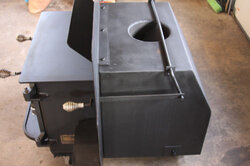 Notice the larger outer shell on the back that allows only the inner firebox to stick out of the hearth.
Notice the larger outer shell on the back that allows only the inner firebox to stick out of the hearth.
They were designed to slide into place and use the existing chimney to vent. They had to be sealed well around the faceplate to avoid indoor air leaking into the chimney and cooling the rising exhaust. The lighter rising gasses in the chimney is what makes any stove work. The higher pressure atmospheric air pressure pushes into the intake vents adding oxygen to the fire. So the chimney is the engine that runs the stove and is more important than the stove itself.
The manual will only show the installation without a liner. They were later used to prevent a much larger than necessary flue from the original fireplace to require too much heat to keep the exhaust rising properly and not forming excessive creosote. So by today's standards it should have a liner the correct size (8") or 50 square inches across to vent all the way up. It is againt code to reduce the size of the flue from the outlet size.
Here's a sweeps site that explains the problems with oversize flues. You can use it if close to the outlet size, but the Insert needs to be removed each time the chimney is cleaned to remove soot that falls behind it. A liner is connected by what is called a "boot" and allows the debris from cleaning to fall into the insert for removal.
http://www.yourashismine.com/id27.html
https://www.hearth.com/images/uploads/fishinsertmanual.pdf
Yours is an early one that used the chain for damper control. Most have the newer handle on the right.
The vent you see on top is a connecting pipe between inner firebox and outer shell that makes an air space for blower to push heated air out the top.
The top of your Insert looks like this;
 Notice the larger outer shell on the back that allows only the inner firebox to stick out of the hearth.
Notice the larger outer shell on the back that allows only the inner firebox to stick out of the hearth.They were designed to slide into place and use the existing chimney to vent. They had to be sealed well around the faceplate to avoid indoor air leaking into the chimney and cooling the rising exhaust. The lighter rising gasses in the chimney is what makes any stove work. The higher pressure atmospheric air pressure pushes into the intake vents adding oxygen to the fire. So the chimney is the engine that runs the stove and is more important than the stove itself.
The manual will only show the installation without a liner. They were later used to prevent a much larger than necessary flue from the original fireplace to require too much heat to keep the exhaust rising properly and not forming excessive creosote. So by today's standards it should have a liner the correct size (8") or 50 square inches across to vent all the way up. It is againt code to reduce the size of the flue from the outlet size.
Here's a sweeps site that explains the problems with oversize flues. You can use it if close to the outlet size, but the Insert needs to be removed each time the chimney is cleaned to remove soot that falls behind it. A liner is connected by what is called a "boot" and allows the debris from cleaning to fall into the insert for removal.
http://www.yourashismine.com/id27.html
So that all seems like it wouldn't be great to do. So I guess my main question would be - if I replaced the wood stove insert with one that has a 6 inch collar (that seems to be what most of the ones I see are) would that work with the 5 1/2 inch liner that they have said they can install?
That would depend on what kind of Insert you want, as in a new one requiring different operation and much better wood. Personal preference, CO$T, and fuel are the deciding factors. If you have less than desirable wood that's not seasoned properly for longer periods you may want the old style. There's a learning curve for the new units with secondary burn technology, so if you're not familiar with their operation it's better to read up on them in the newer EPA approved forum before realizing the difference after the fact.
I assume they are referring to installing an oval liner that fits the existing flue similar to this;
http://www.rockfordchimneysupply.com/ovalliner.php
Use the drop down list for sizes available for all sorts of existing flues.
Flue size is determined by the outlet size of the appliance in square inches, and should be the same as flue outlet of appliance all the way up. Yours is 8 inch as built or 50.24 sq inches. It is not legal to reduce the size, however this Insert and the 8 inch freestanding Fisher Stoves physically work fine with reduced flue to 6 inch round. The reason they are designed with the larger 8 inch is for open door burning with screen in place in "Fireplace Mode". There is no smoke roll in problem with open door burning. Since this insert was designed for existing fireplace flues that were mush larger, making it more efficient with a 6 inch would not always allow enough heat up a larger fireplace flue and cause even more creosote accumulation. So there were reasons why it was designed with the larger outlet. Codes were written to prevent reducing the flue size and choking a stove that requires the size they are built with. Codes don't take into consideration every scenario and this is one that physically works well with a 6 inch insulated flue, but isn't legal due to the way the codes are written. It is VERY common in the US to find 8 inch stoves reduced to 6 that work well, but that doesn't make it legal.
It's not a big deal connecting this older Insert, and you may need a oval to round adapter to connect a newer Insert with 6 inch collar. The chimney pros on here can tell you if and which oval liners can can be formed round at the end to fit.
I assume they are referring to installing an oval liner that fits the existing flue similar to this;
http://www.rockfordchimneysupply.com/ovalliner.php
Use the drop down list for sizes available for all sorts of existing flues.
Flue size is determined by the outlet size of the appliance in square inches, and should be the same as flue outlet of appliance all the way up. Yours is 8 inch as built or 50.24 sq inches. It is not legal to reduce the size, however this Insert and the 8 inch freestanding Fisher Stoves physically work fine with reduced flue to 6 inch round. The reason they are designed with the larger 8 inch is for open door burning with screen in place in "Fireplace Mode". There is no smoke roll in problem with open door burning. Since this insert was designed for existing fireplace flues that were mush larger, making it more efficient with a 6 inch would not always allow enough heat up a larger fireplace flue and cause even more creosote accumulation. So there were reasons why it was designed with the larger outlet. Codes were written to prevent reducing the flue size and choking a stove that requires the size they are built with. Codes don't take into consideration every scenario and this is one that physically works well with a 6 inch insulated flue, but isn't legal due to the way the codes are written. It is VERY common in the US to find 8 inch stoves reduced to 6 that work well, but that doesn't make it legal.
It's not a big deal connecting this older Insert, and you may need a oval to round adapter to connect a newer Insert with 6 inch collar. The chimney pros on here can tell you if and which oval liners can can be formed round at the end to fit.
Thanks Coaly
The company that came to look at putting in the chimney liner said he could do it - but as I said it would be a 5 1/2 inch insert. He didn't seem worried about code. Although he did say the town would prefer it if people replaced these older units. Maybe things are different in Canada? His only concern really seemed to be that whenever I opened the stove I would get a lot of smoke coming into the room.
The company that came to look at putting in the chimney liner said he could do it - but as I said it would be a 5 1/2 inch insert. He didn't seem worried about code. Although he did say the town would prefer it if people replaced these older units. Maybe things are different in Canada? His only concern really seemed to be that whenever I opened the stove I would get a lot of smoke coming into the room.
Well, 5 1/2 definitely is not going to work. If he said there's no liner that can be removed so that a 6" pipe, wrapped with 1" of insulation can be installed then maybe ask him how much to tear down the chimney and rebuild from the ground up? Or just get another estimate. You'll find someone who will be willing to do it right.
So Coaly - your thinking if I did put in a 5 1/2 oval liner with this stove that things would work out okay?
Yes, it's all about square inch area of the outlet and not choking it off too small. This is not a guess, it's a mathematical formula. To find the square inch area of a circle, the formula is radius or r squared X pi. Radius is half the circle. For the 8 inch outlet that would be 4 X 4 =16 X 3.14 (pi) = 50.24 square inches.
A square flue being 7.5" square would be 7.5 X 7.5 = 56.25 square inches, so that would be acceptable. Next take your flue measurements and multiply each side and you get your current square inch area. That will be far more and too much area to heat, reducing the efficiency. We know this stove physically works with 6 inch round, or r 3 X 3 = 9 X 3.14 or 28.26 square inches. An oval liner 5 1/2 by whatever the wider part is will be more than 28.26, possibly nearing as much as 50.24, the equivalent to the 8 inch round. Once you know what size the liner measures, use the correct formula for finding square inch area.
I think MJ above means 5 1/2 round (that would be 23.74 square inches) would not work being much smaller than the 6 minimum we know works..
A square flue being 7.5" square would be 7.5 X 7.5 = 56.25 square inches, so that would be acceptable. Next take your flue measurements and multiply each side and you get your current square inch area. That will be far more and too much area to heat, reducing the efficiency. We know this stove physically works with 6 inch round, or r 3 X 3 = 9 X 3.14 or 28.26 square inches. An oval liner 5 1/2 by whatever the wider part is will be more than 28.26, possibly nearing as much as 50.24, the equivalent to the 8 inch round. Once you know what size the liner measures, use the correct formula for finding square inch area.
I think MJ above means 5 1/2 round (that would be 23.74 square inches) would not work being much smaller than the 6 minimum we know works..
And yes, Canada is different. You have a WETT inspection and your codes are more strict. Provinces are different and criteria varies.
We have NFPA (National Fire Protection Agency) that sets the standard 211 for soild fuel burning appliances. Government and local authorities adopt these standards into their codes. Local authorities can make their rules stricter, but the minimum is set nationwide by the standard. (The standard states all UL listed stoves must be installed as per installation instructions that are also approved, so each model can vary) EPA regulates smoke and was the reason Fisher along with many others closed in 1988 as the particulate size became too small to achieve. This has been the standard set by them for 15 years and we are going through changes now that become more strict for particulate and must reduce by 80% by I believe 2020. New technology will have to be discovered for most stove makers to continue much like what happened in 1988. Many fear the cost of newer technology will put the stoves out of reach for most, so many will revert to older stoves that are exempt making the air quality worse.
This explains the WETT Cert.; http://www.abovegradehomeinspections.ca/Articles/the-truth-about-wett-inspections-and-certification
We have NFPA (National Fire Protection Agency) that sets the standard 211 for soild fuel burning appliances. Government and local authorities adopt these standards into their codes. Local authorities can make their rules stricter, but the minimum is set nationwide by the standard. (The standard states all UL listed stoves must be installed as per installation instructions that are also approved, so each model can vary) EPA regulates smoke and was the reason Fisher along with many others closed in 1988 as the particulate size became too small to achieve. This has been the standard set by them for 15 years and we are going through changes now that become more strict for particulate and must reduce by 80% by I believe 2020. New technology will have to be discovered for most stove makers to continue much like what happened in 1988. Many fear the cost of newer technology will put the stoves out of reach for most, so many will revert to older stoves that are exempt making the air quality worse.
This explains the WETT Cert.; http://www.abovegradehomeinspections.ca/Articles/the-truth-about-wett-inspections-and-certification
I'm just saying that, the inner liner measurement as it is now is 6 1/4", so a 5 1/2 oval liner wont allow you to use a proper insulated wrap. This wouldn't even allow a 1/2" insulated wrap. Oval liners are a great way of doing some chimneys but I dont think it would be the fix all in this particular case. Plus, the way smoke spirals a round liner gives better performance and draft "usually" over a similar oval liner. Obviously either will be much better than the rectangle shaped flu there now. The important question hasn't been answered here yet. What is the chimney? Is that liner that appears to be poured concrete sections the entire chimney or is that a liner within a brick outer structure? If it's what I assume it is, I still say have the concrete liner removed so you can do a proper round liner with a proper 1" insulated wrap. This is probably code in your area anyways and will certainly be code if there are combustibles nearby.
- Status
- Not open for further replies.
Similar threads
- Replies
- 3
- Views
- 236
- Replies
- 3
- Views
- 2K
- Replies
- 10
- Views
- 880
- Replies
- 60
- Views
- 6K


